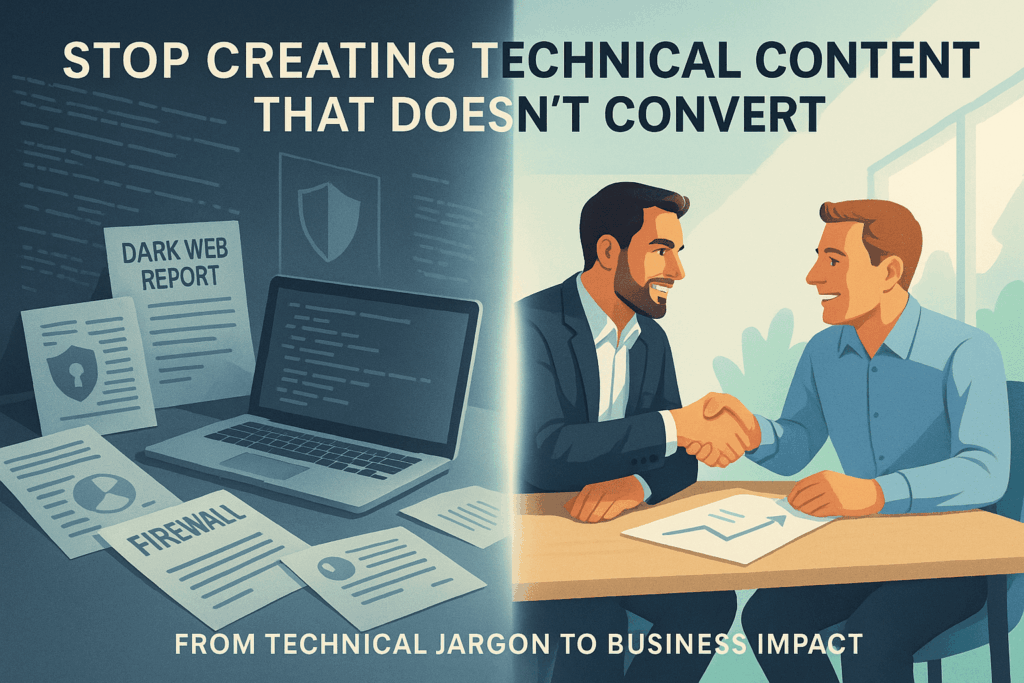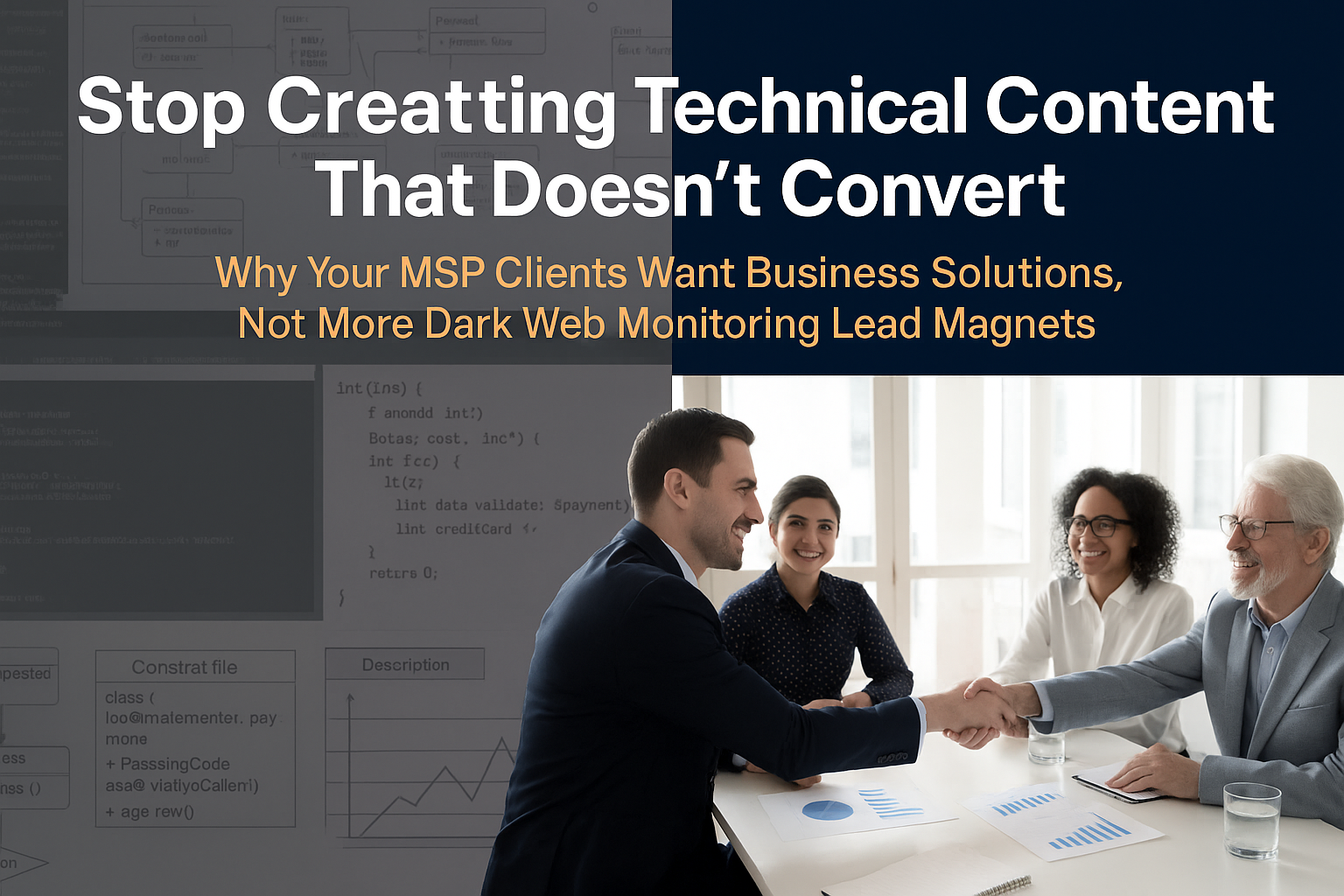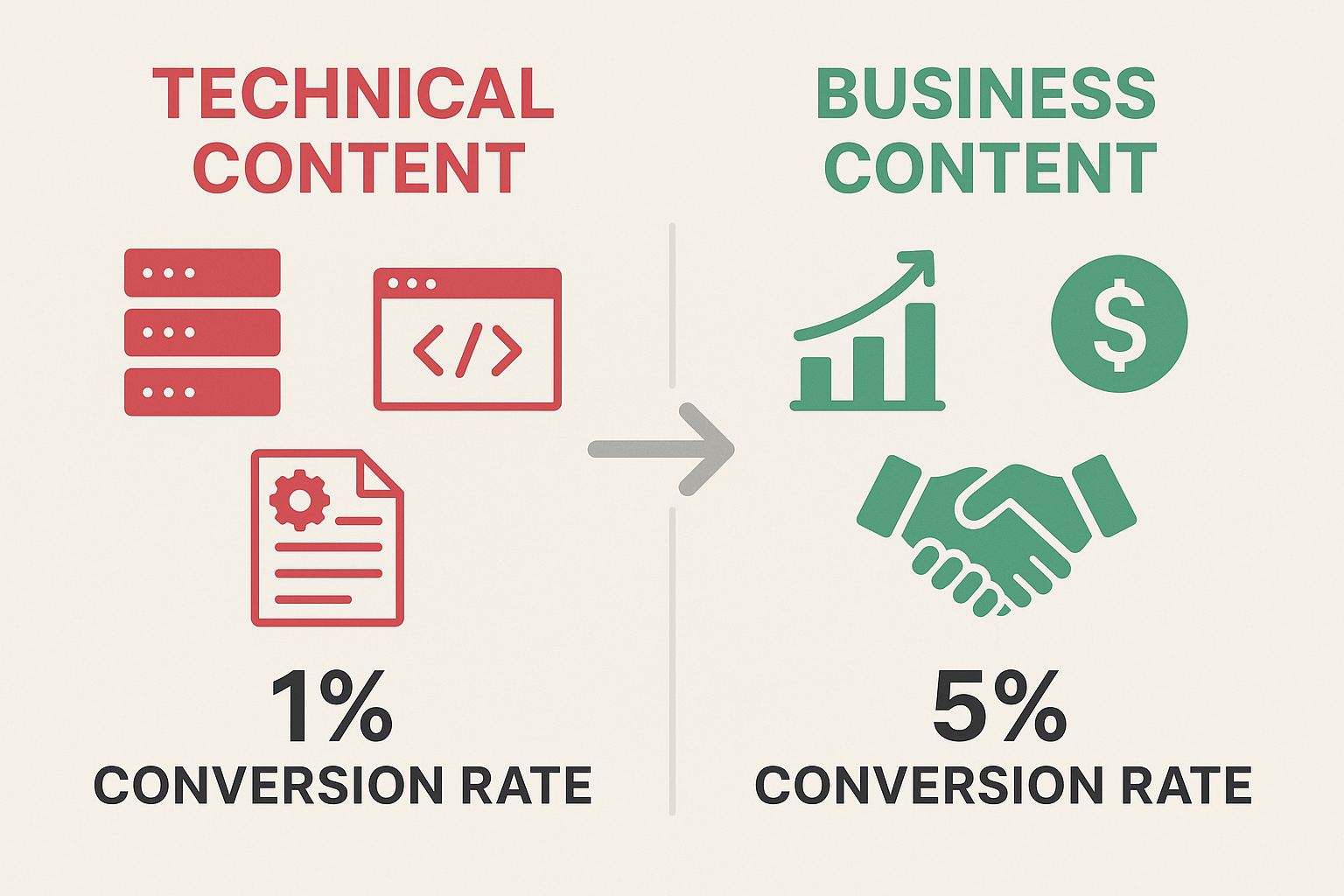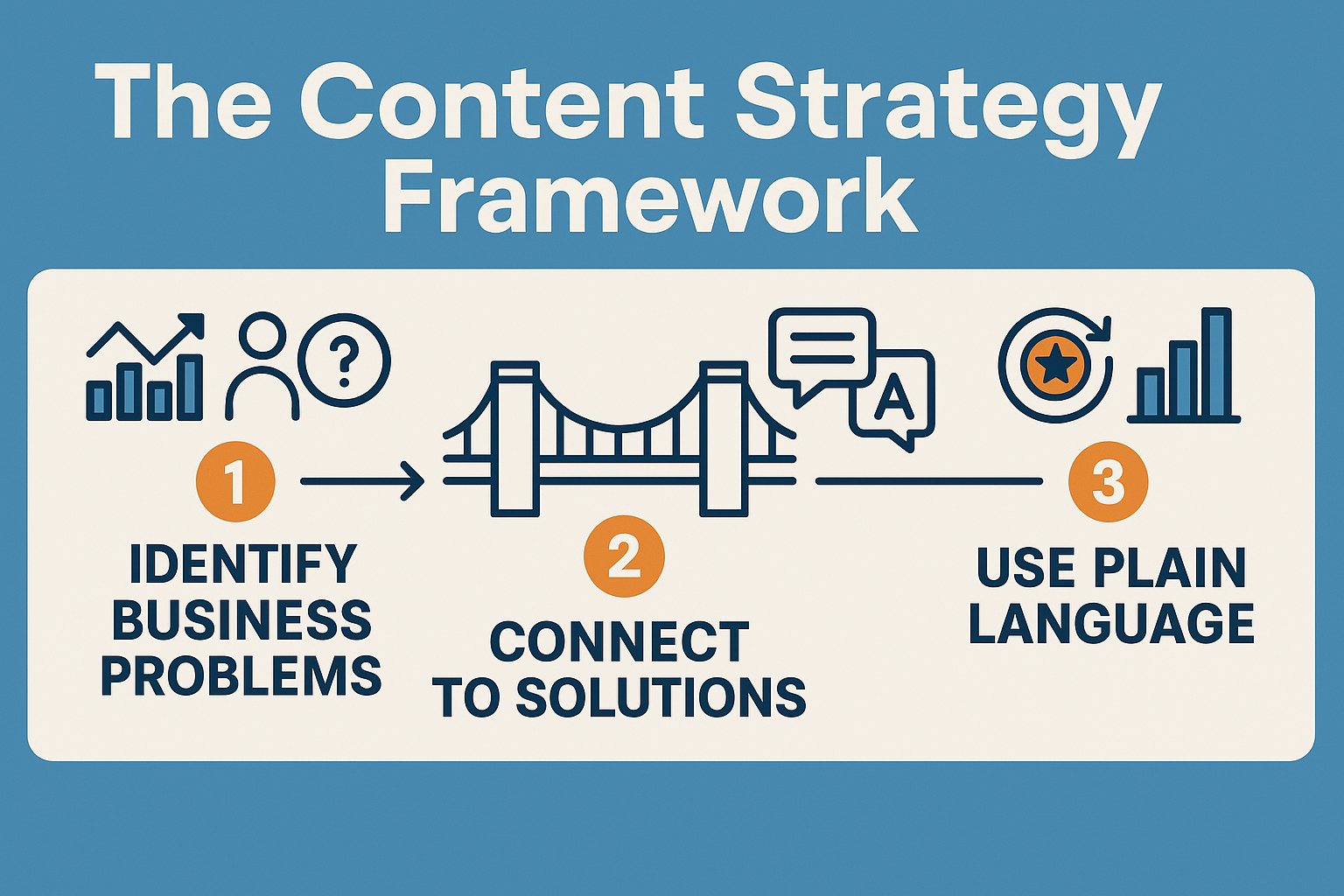Stop Technical Content That Doesn’t Convert

Picture this: You’ve just spent hours crafting the perfect whitepaper about the latest cybersecurity threats, complete with technical diagrams and industry jargon. You’re convinced it’s going to generate dozens of qualified leads. But weeks later, your download numbers are disappointing, and the few people who did engage aren’t converting into paying clients.
Sound familiar?
Here’s the hard truth that most MSPs refuse to accept: Your ideal clients don’t want another technical deep-dive into network security protocols or another dark web monitoring lead magnet. They want content that speaks directly to their real business challenges, the ones keeping them awake at 3 AM worrying about payroll, cash flow, and whether their business will survive the next economic downturn.
I’ve seen countless MSPs make this mistake, and frankly, I made it myself for years. We get so caught up in showcasing our technical expertise that we forget our clients hired us to solve business problems, not to impress them with our knowledge of firewall configurations.
Key Takeaways

Ready to See How MSPs Are Getting Leads on Autopilot?
Stop wasting time trying to figure out marketing from scratch. In this live demo, we’ll show you how we’ve already built and tested complete campaigns for MSPs just like yours. Everything is ready to launch, all you need to do is plug in and start booking calls.
✅ Proven campaigns designed specifically for MSPs
✅ A complete lead generation system already set up and ready
✅ Real examples of how MSPs are using it to consistently win new clients
✅ Immediate implementation, no need to reinvent the wheel
📅 Book a Demo Now- Business-focused content converts better than technical content because it addresses real pain points your clients face daily
- Your ideal client cares more about outcomes (reduced downtime, improved productivity, cost savings) than technical specifications
- Lead magnets should solve immediate business problems rather than educate about technical concepts
- Storytelling and real-world examples resonate more than feature lists and technical comparisons
- Content that connects technology to business impact positions you as a strategic partner, not just a vendor
The Technical Content Trap That’s Killing Your Lead Generation
Why MSPs Default to Technical Content
Let’s be honest, creating technical content feels safer. We know our stuff when it comes to servers, networks, and security protocols. It’s comfortable territory. When a new ransomware variant hits the news, our first instinct is to write a detailed breakdown of how it works, what vulnerabilities it exploits, and the technical steps to prevent it.
But here’s what I’ve learned after working with hundreds of MSPs: your prospects don’t hire you because you can explain how a zero-day exploit works. They hire you because you can prevent their business from losing $50,000 when their systems go down.
The Real Cost of Technical-Heavy Marketing
I remember working with an MSP owner named Mike who was frustrated with his marketing results. He showed me his content library, dozens of technical guides, whitepapers about compliance frameworks, and detailed comparisons of backup solutions. All expertly written, all technically accurate, and all completely ineffective at generating qualified leads.
“I don’t understand,” Mike said. “This content shows we really know our stuff. Why aren’t people downloading it?”
The answer was simple: Mike was creating content for other IT professionals, not for his ideal clients, busy business owners who just wanted their technology to work reliably so they could focus on growing their companies.
Challenge 1: Your Clients Don’t Speak Your Technical Language

The Problem: Lost in Translation
When you create content filled with acronyms, technical specifications, and industry jargon, you’re essentially speaking a foreign language to your ideal clients. A restaurant owner doesn’t need to understand the difference between WPA2 and WPA3 encryption; they need to know their customer payment data is secure and their reputation is protected.
Why This Matters
Your prospects are drowning in technical information they can’t process. Every vendor they talk to throws around terms like “next-generation firewalls,” “AI-powered threat detection,” and “zero-trust architecture.” It all sounds impressive, but none of it helps them understand how these solutions will impact their bottom line.
The Solution: Translate Technology into Business Outcomes
Instead of explaining how your backup solution uses incremental block-level replication, talk about how it ensures they’ll never lose more than 15 minutes of work if their server crashes. Instead of detailing your network monitoring capabilities, explain how you’ll catch problems before they cause expensive downtime.
Example transformation:
– Technical approach: “Our advanced endpoint detection and response solution uses behavioral analysis and machine learning algorithms to identify and neutralize threats in real-time.”
– Business-focused approach: “We monitor your computers 24/7 to catch problems before they can shut down your business or steal your customer data.”
Challenge 2: Dark Web Monitoring Lead Magnets Are Everywhere (And They Don’t Work)
The Problem: Commodity Content in a Crowded Market
If I had a dollar for every “Dark Web Monitoring Report” or “Cybersecurity Assessment” lead magnet I’ve seen, I could retire tomorrow. These generic offerings have become so common that they’re essentially invisible to your prospects. Worse, they attract tire-kickers and competitors, not qualified buyers.
Why This Matters
Generic technical lead magnets train your prospects to expect free technical services without buying anything. You end up with a list full of people who want free assessments, free reports, and free consultations, but who disappear the moment you mention your actual services and pricing.
I’ve seen MSPs generate hundreds of leads with dark web monitoring reports, only to convert less than 2% into paying clients. That’s not lead generation, that’s lead collection, and there’s a huge difference.
The Solution: Create Business-Problem-Focused Lead Magnets
Your lead magnets should address specific business challenges your ideal clients face. Instead of offering another cybersecurity assessment, create content that helps them solve real problems.
Winning lead magnet ideas:
– “The 5-Minute Daily Checklist That Prevents 90% of IT Disasters”
– “How to Cut Your IT Costs by 30% Without Sacrificing Security”
– “The Business Owner’s Guide to Avoiding Expensive Downtime”
– “3 Simple Steps to Ensure Your Business Survives a Cyber Attack”
Notice how each of these focuses on business outcomes (saving money, preventing disasters, ensuring survival) rather than technical processes.
Challenge 3: You’re Competing on Features Instead of Outcomes

The Problem: The Specification Sheet Mentality
Most MSP marketing reads like a product specification sheet. We list our services and detail our technical capabilities, hoping prospects will be impressed enough to contact us. But business owners don’t care about your RMM tool’s feature set; they care about results.
Why This Matters
When you compete on features, you become a commodity. Every MSP offers network monitoring, backup services, and cybersecurity. When prospects can’t differentiate between providers based on outcomes, they default to choosing the cheapest option.
The Solution: Lead with Business Impact
Start every piece of content with the business problem you’re solving, then work backward to the technical solution. Your prospects need to understand the “why” before they care about the “how.”
Framework for business-focused content:
- Identify the business problem (lost productivity, security risks, compliance issues)
- Quantify the impact (downtime costs, potential fines, lost revenue)
- Present your solution in business terms (faster recovery, reduced risk, ensured compliance)
- Support with technical details (only if relevant to the business outcome)
MSP Content Strategy Assessment
Evaluate how well your content connects with business owners' real needs
1. What's the primary focus of your most recent lead magnet?
2. How do you typically describe your services?
3. What language dominates your marketing content?
4. What's your main content goal?
5. How do you measure content success?
Ready to See How MSPs Are Getting Leads on Autopilot?
Stop wasting time trying to figure out marketing from scratch. In this live demo, we’ll show you how we’ve already built and tested complete campaigns for MSPs just like yours. Everything is ready to launch, all you need to do is plug in and start booking calls.
✅ Proven campaigns designed specifically for MSPs
✅ A complete lead generation system already set up and ready
✅ Real examples of how MSPs are using it to consistently win new clients
✅ Immediate implementation, no need to reinvent the wheel
📅 Book a Demo NowChallenge 4: Your Content Attracts Tire-Kickers, Not Buyers

The Problem: Quality vs. Quantity Lead Generation
When you offer generic technical assessments and reports, you attract individuals who are looking for free resources, rather than those who are ready to invest in professional IT services. These leads might look good on paper, but they rarely convert into profitable, long-term clients.
Why This Matters
Not all leads are created equal. A single qualified prospect who understands the value of professional IT services is worth more than 100 people who downloaded your free cybersecurity checklist but have no intention of paying for managed services.
I learned this lesson the hard way when I helped an MSP generate 500 leads in three months with a “Free Network Assessment” campaign. Sounds great, right? Wrong. After following up with all 500 leads, they closed exactly three new clients, and two of those were already in their sales pipeline from other sources.
The Solution: Create Content That Pre-Qualifies Prospects
Your content should naturally filter out bargain hunters and attract business owners who understand the value of professional IT services. This means focusing on business outcomes that matter to decision-makers with real budgets.
Pre-qualifying content strategies:
– Case studies that show ROI and business impact
– Problem-solving guides that require investment to implement
– Strategic planning tools that appeal to growth-minded business owners
– Cost-benefit calculators that demonstrate value
Challenge 5: You’re Not Connecting Technology to Business Impact
The Problem: The Technical Solution Without the Business Context
Most MSPs present their services as a list of technical capabilities without explaining how those capabilities translate into business benefits. You might mention that you provide “24/7 network monitoring,” but you don’t explain that this means their employees can work productively without worrying about system crashes during critical deadlines.
Why This Matters
Business owners buy outcomes, not processes. They don’t care about your monitoring tools; they care about avoiding the embarrassment and financial loss of having their systems crash during an important client presentation.
The Solution: Always Lead with Business Impact
Every piece of content should start with a business problem and work toward the technical solution, not the other way around. Your prospects need to understand why they should care before you explain how you’ll solve their problem.
Business impact framework:
- Start with the business pain point (lost productivity, security risks, compliance issues)
- Quantify the potential cost (downtime expenses, potential fines, lost opportunities)
- Present your solution in business terms (faster recovery, reduced risk, ensured compliance)
- Support with technical details (only as needed to build confidence)
The Content That Actually Converts: Real-World Examples

Case Study: From Technical Whitepapers to Business Solutions
Let me share a story about Sarah, an MSP owner who completely transformed her lead generation by changing her content approach. She used to create detailed technical guides about backup strategies, network security protocols, and compliance frameworks. Her content was technically excellent, but it wasn’t generating qualified leads.
Here’s what she changed:
Old approach: “The Complete Guide to 3-2-1 Backup Strategies for Small Business Networks”
New approach: “How to Sleep Better at Night Knowing Your Business Data is 100% Protected”
Old approach: “Understanding Advanced Persistent Threats in the Modern Cybersecurity Landscape”
New approach: “The 3 Most Common Ways Hackers Target Small Businesses (and How to Stop Them)”
Old approach: “HIPAA Compliance Technical Requirements for Healthcare IT Infrastructure”
New approach: “How to Avoid a $4.3 Million HIPAA Fine (Real Case Study + Prevention Checklist)”
The results? Sarah’s lead quality improved dramatically. Instead of attracting IT managers looking for free technical information, she started generating conversations with business owners who had real budgets and decision-making authority.
Let me share a story about Sarah, an MSP owner who completely transformed her lead generation by changing her content approach. She used to create detailed technical guides about backup strategies, network security protocols, and compliance frameworks. Her content was technically excellent, but it wasn’t generating qualified leads.
Here’s what she changed:
Old approach: “The Complete Guide to 3-2-1 Backup Strategies for Small Business Networks”
New approach: “How to Sleep Better at Night Knowing Your Business Data is 100% Protected”
Old approach: “Understanding Advanced Persistent Threats in the Modern Cybersecurity Landscape”
New approach: “The 3 Most Common Ways Hackers Target Small Businesses (and How to Stop Them)”
Old approach: “HIPAA Compliance Technical Requirements for Healthcare IT Infrastructure”
New approach: “How to Avoid a $4.3 Million HIPAA Fine (Real Case Study + Prevention Checklist)”
The results? Sarah’s lead quality improved dramatically. Instead of attracting IT managers looking for free technical information, she started generating conversations with business owners who had real budgets and decision-making authority.
The Power of Storytelling Over Specifications
Instead of listing the features of your backup solution, tell the story of the restaurant owner who avoided bankruptcy because your systems restored all their data after a ransomware attack. Instead of explaining your network monitoring capabilities, share how you prevented a law firm from missing a critical court deadline by catching a server issue before it caused downtime.
Story structure that works:
- Introduce a relatable business owner with a common problem
- Show the potential consequences of not addressing the issue
- Demonstrate how your solution prevented disaster or solved the problem
- Quantify the business impact (money saved, disasters avoided, peace of mind gained)
Building Content That Positions You as a Strategic Partner
Moving Beyond the “IT Guy” Perception
When your content focuses on technical solutions, you position yourself as a vendor who implements technology. When your content focuses on business outcomes, you position yourself as a strategic partner who helps businesses grow and succeed.
Strategic partner content includes:
– Business growth strategies that leverage technology
– Cost optimization guides that show ROI
– Risk management frameworks that protect business assets
– Productivity improvement plans that boost profitability
The Consultant vs. Vendor Distinction
Vendors sell products and services. Consultants solve problems and drive results. Your content should position you firmly in the consultant category by focusing on business outcomes rather than technical capabilities.
Vendor language: “We provide comprehensive network monitoring services with 24/7 support and advanced threat detection capabilities.”
Consultant language: “We ensure your business never loses money to preventable IT problems by catching issues before they impact your operations.”
Creating Your Business-Focused Content Strategy
Step 1: Identify Your Clients’ Real Business Problems
Before you create any content, you need to understand what actually keeps your ideal clients awake at night. Hint: it’s not usually technical issues. It’s business problems that technology can solve.
Common business problems your clients face:
– Cash flow concerns (can’t afford expensive downtime)
– Growth challenges (technology holding back expansion)
– Compliance stress (fear of fines and legal issues)
– Productivity issues (employees wasting time on IT problems)
– Security anxiety (fear of cyber attacks and data breaches)
– Reputation protection (avoiding embarrassing IT failures)
Step 2: Connect Each Problem to Your Solutions
For every business problem you identify, create content that shows how your services provide solutions. But remember, lead with the business impact, not the technical implementation.
Content mapping example:
– Business Problem: Fear of expensive downtime
– Content Topic: “How to Eliminate 99% of Unexpected IT Downtime”
– Technical Solution: Proactive monitoring and maintenance
– Business Outcome: Reliable operations and protected revenue
Step 3: Use Language Your Clients Actually Understand
Eliminate technical jargon and industry acronyms from your content. Write like you’re explaining things to your non-technical family members. If you must use technical terms, immediately explain what they mean in a business context.
Language transformation examples:
– Instead of: “Multi-factor authentication”
– Use: “Double-checking user identity to prevent unauthorized access”
– Instead of: “Endpoint detection and response”
– Use: “Monitoring every computer to catch problems early”
– Instead of: “Business continuity planning”
– Use: “Ensuring your business keeps running no matter what happens”
Measuring Success: Quality Over Quantity
New Metrics That Actually Matter
Stop measuring success by download numbers and start measuring by business outcomes. The goal isn’t to generate the most leads, it’s to generate the best leads.
Metrics that matter:
– Qualified consultation requests (not just any downloads)
– Sales conversation quality (are prospects pre-educated and ready to buy?)
– Client acquisition cost (are you attracting buyers or tire-kickers?)
– Average deal size (business-focused content attracts bigger budgets)
– Sales cycle length (educated prospects make decisions faster)
The Long-Term Benefits of Business-Focused Content
When you consistently create content that addresses real business problems, several things happen:
- You attract higher-quality prospects who understand the value of professional IT services
- You position yourself as a strategic partner rather than just another IT vendor
- You command higher prices because prospects see you as a business consultant, not a commodity service provider
- You enjoy shorter sales cycles because your content pre-educates prospects about the value you provide
- You build stronger client relationships because you’re solving real business problems, not just technical issues
Conclusion: Your Next Steps to Content That Converts
It’s time to get out of the idea that your clients want to consume content that is technical. Your ideal client wants to consume content that is designed to solve their actual business problems, not another dark web monitoring lead magnet.
The MSPs who thrive in 2025 and beyond will be those who understand this fundamental shift. Technology is just the tool; business outcomes are what matter.
Here’s what you need to do right now:
- Audit your existing content – How much focus on technical features vs. business outcomes?
- Survey your best clients – What business problems were they trying to solve when they hired you?
- Rewrite your lead magnets – Focus on solving specific business problems rather than showcasing technical knowledge
- Transform your service descriptions – Lead with business impact, support with technical capabilities
- Create client success stories – Show real business outcomes, not just technical implementations
Remember, your prospects don’t need another explanation of how firewalls work. They need to understand how reliable IT infrastructure will help them sleep better at night, grow their business faster, and avoid the devastating costs of IT disasters.
The choice is yours: continue creating technical content that impresses your peers but fails to generate qualified leads, or start creating business-focused content that attracts the kind of clients who value what you do and are willing to pay well for it.
Your ideal clients are out there right now, searching for solutions to their business problems. Make sure your content is speaking their language when they find you.
Ready to See How MSPs Are Getting Leads on Autopilot?
Stop wasting time trying to figure out marketing from scratch. In this live demo, we’ll show you how we’ve already built and tested complete campaigns for MSPs just like yours. Everything is ready to launch, all you need to do is plug in and start booking calls.
✅ Proven campaigns designed specifically for MSPs
✅ A complete lead generation system already set up and ready
✅ Real examples of how MSPs are using it to consistently win new clients
✅ Immediate implementation, no need to reinvent the wheel
📅 Book a Demo NowI’ve been in the IT industry for over 15 years and still an actively owner of an MSP, based in Atlanta, GA. We serve clients across industries like medical, finance, manufacturing and automotive and we’re constantly refining our operations, sales, and marketing processes to stay ahead.
Through trial, error, and real-world wins, I learned what actually works to grow an MSP and what’s just noise. That’s why I created MSP Hub HQ: to give other MSP owners access to the same proven systems we use every day to generate leads, book appointments, and close new business.
If you're tired of guessing your way through marketing, this webinar will show you exactly how to shortcut the process with strategies that are already working in the field.

